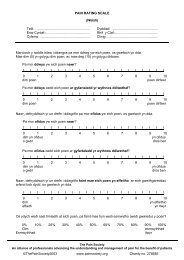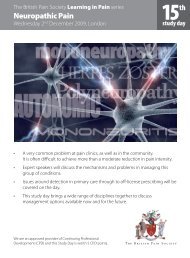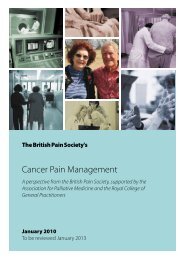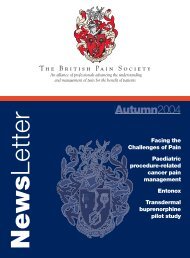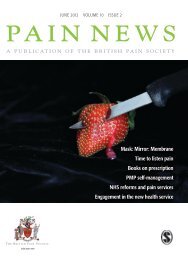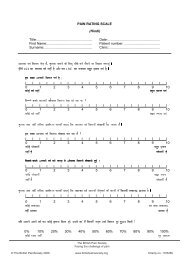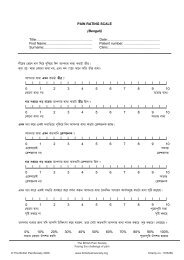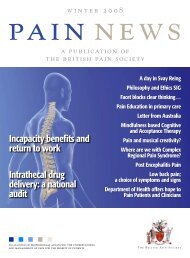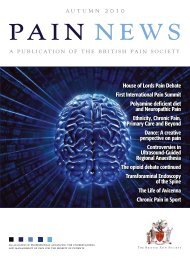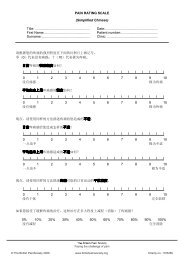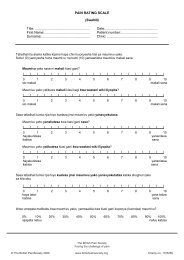Summer 2010 - The British Pain Society
Summer 2010 - The British Pain Society
Summer 2010 - The British Pain Society
Create successful ePaper yourself
Turn your PDF publications into a flip-book with our unique Google optimized e-Paper software.
For the treatment of neuropathic pain associated with post-herpetic neuralgia<br />
Works where it hurts<br />
Versatis is a novel analgesic plaster which<br />
delivers 5% lidocaine topically. 1<br />
Versatis has demonstrated sustained efficacy 2<br />
and has a reassuring safety and tolerability profile 1,3<br />
Adverse events should be reported. Reporting forms<br />
and information can be found at: www.yellowcard.gov.uk.<br />
Adverse events should also be reported to Grünenthal Ltd<br />
(tel: 0870 351 8960)<br />
V0833. Date of preparation: January <strong>2010</strong>.<br />
Versatis 5% medicated plaster. Refer to the Summary of Product Characteristics (SPC) for<br />
full details on side effects, warnings and contra-indications before prescribing. Presentation:<br />
Versatis is a medicated plaster (10cm x 14cm) containing 700 mg (5% w/w) of lidocaine in<br />
an aqueous adhesive base. Indication: Symptomatic relief of neuropathic pain associated with<br />
previous herpes zoster infection (post-herpetic neuralgia, PHN). Dosage and method<br />
of administration: Adults and elderly patients: Use up to three plasters for up to 12 hours,<br />
followed by at least a 12 hour plaster-free interval. Cover painful area once daily. Apply<br />
the plaster to intact, dry, non-irritated skin (after healing of the shingles). Remove hairs in<br />
affected area with scissors (do not shave). Remove the plaster from sachet and its surface liner<br />
before applying immediately to the skin. Plasters may be cut to size. Re-evaluate treatment after<br />
2 to 4 weeks. Patients under 18 years: Not recommended. Contra-indications: Hypersensitivity to<br />
active substance, any excipients, or local anaesthetics of amide type (e.g. bupivacaine, etidocaine,<br />
mepivacaine and prilocaine). Do not apply to inflamed or injured skin (e.g. active herpes zoster<br />
lesions, atopic dermatitis or wounds). Warnings and precautions: Should not apply to mucous<br />
membranes or the eyes. Plasters contain propylene glycol which may cause skin irritation, methyl<br />
parahydroxybenzoate and propyl parahydroxybenzoate which may cause allergic reactions.<br />
Use with caution in patients with severe cardiac impairment, severe renal impairment or severe<br />
hepatic impairment. In animals, metabolites of lidocaine have been shown to be genotoxic,<br />
carcinogenic and mutagenic, with unknown clinical significance. Interactions: No clinically<br />
relevant interactions have been observed in clinical studies. Absorption of lidocaine from the<br />
skin is low. Use with caution in patients receiving Class I antiarrhythmic drugs (e.g. tocainide,<br />
mexiletine) or other local anaesthetics. Pregnancy and lactation: Do not use during pregnancy<br />
or breast-feeding. Undesirable effects: Very common (≥10%): administration site reactions<br />
(e.g. erythema, rash, pruritus, burning). Uncommon (>0.1%-≤1%): skin injury, skin lesion.<br />
Very rare (




